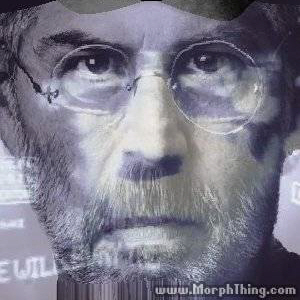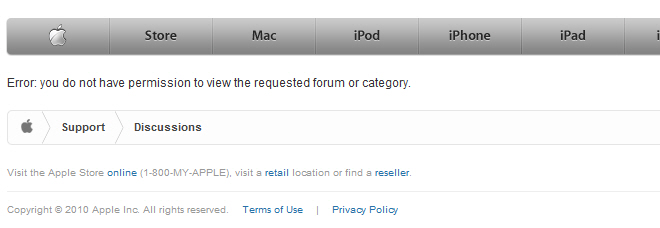To be clear, I am not an Apple hater. My history with Apple goes back to a time before many of you reading this were born. The company’s foresight and design prowess have always been a source of inspiration and personal admiration.

Morphed image provides conclusive proof that Big Brother from Apple's 1984 Macintosh launch ad is actually Steve Jobs from the future!
In college, the Apple II changed my life. It was soon apparent that accounting homework and the pressure on teaching assistants to grade final exams and enter semester grades would never be the same with VisiCalc’s spreadsheet and database capabilities.
While I had some previous experience “re-purposing” (OK, hacking) my high school’s career computer to play Hewlett Packard Football on the University of Washington mainframe, that was only accessing a comm link and spoofing a password. With the Apple II, I got my first experience in social computing by recoding the binary tree game to guess fetishes instead of animals.
Apple made microcomputers both useful and fun. I became an Apple fanboy in 1979.
A couple years later, in 1981, Apple let me down the first time with the remarkably expensive $7,500 Apple III. I tried every trick in the book to have it come out ahead of an IBM PC in head to head comparisons, but sadly had to advise my company that a PC was the way to go. I then looked like a genius when the Apple III’s were recalled due to overheating problems. The valuable lesson learned was to follow my head, not my heart, when it comes to making technology decisions.
Then, in 1983, Apple introduced LISA – their first attempt at a graphical user interface. This time, woefully insufficient performance was paired with the exorbitantly high price of $10,000. Unfortunately, my corporate office drank the promotional kool-aid and committed to buying 22 units before they were released with the goal of using them to integrate and roll-up the annual budgeting. It didn’t work.
Instead, in what may be the first, and perhaps only, occurrence of a hotel owner hiding a technology purchase from a hotel management company, I worked with our hotel owners to covertly purchase (it was quietly expensed as Repairs & Maintenance – Furniture, Fixtures & Equipment) an IBM PC XT loaded with Lotus 1-2-3. Before the other hotels in the chain could figure out how to keep the LISA spreadsheet from crashing when data was added to the budget template, I managed to complete the annual budget, develop a daily revenue report database and automate the beverage inventory.
1984 Changed Everything
Partially due to the setbacks referenced above, as well as an army of hardware manufacturers pumping out PC-Clones, IBM was dominating the market. Apple was losing ground to IBM and could not afford another product failure.
Thanks to the creative genius of Chiat/Day and the direction of Ridley Scott, the one-time presentation during the 3rd quarter of Super Bowl introduction of the Apple Macintosh computer left an indelible impression on the world of advertising, technology and the consumer psyche. It has been frequently revered as one of the best television commercials ever produced:
So here is a little test. Is the script below transcribed from the script of the Apple “1984” Super Bowl ad, or Steve Jobs’ latest introduction of the iPhone 4?
Big Brother:
“Today, we celebrate the first glorious anniversary of the Information Purification Directives.
We have created, for the first time in all history, a garden of pure ideology.
Where each worker may bloom, secure from the pests purveying contradictory thoughts.
Our Unification of Thought is more powerful a weapon than any fleet or army on earth.
We are one people, with one will, one resolve, one cause.
Our enemies shall talk themselves to death and we will bury them with their own confusion.
We shall prevail!”
Announcer:
“On January 24th Apple Computer will introduce Macintosh. And you’ll see why 1984 won’t be like 1984.”
I guess that last part made the test a bit simpler than I had hoped…
To put the creation of this ad into proper context, one really should view the keynote address delivered by Mr. Jobs in late 1983 that introduced the commercial:
Here is Jobs’ treatise introducing the 1984 commercial:
“It is now 1984. It appears IBM wants it all. Apple is perceived to be the only hope to offer IBM a run for its money. Dealers, initially welcoming IBM with open arms, now fear an IBM dominated and controlled future. They are increasingly and desperately turning back to Apple as the only force that can ensure their future freedom. IBM wants it all and is turning its guns on its last obstacle to industry control… Apple. Will Big Blue dominate the entire computer industry? The entire information age? Was George Orwell right about 1984?”
Pretty strong words. Significant accusations. Most people weren’t that familiar with George Orwell’s 1949 dystopian novel Nineteen Eighty-Four, except in name. However, the speech capitalized on imagery based on the work of a much better known George – Lucas who had completed his original Star Wars trilogy the prior year. Clearly, Apple was leading the Rebel alliance and IBM was the evil Empire.
Let’s move forward more than a quarter century to 2010 and see how Steve Jobs characterizes the launch of iPhone 4:
The full video is just under two hours, but the 10 minutes between 1:18:40 and 1:28:30 hits at the crux of the issue: iAds. Steve earnestly claims that Apple is doing iAds “for one simple reason – To help our developers earn money so they continue to create free and low cost apps.”
He then elucidates on the glories of iAds:
- They keep people in the Apps
- It’s built into the iOS operating system
- Apple sells & hosts the ads
- Developers get 60% of the revenues
It seems the last two points are where the rubber meets the road. The simple reason truly is money, but not solely to benefit of the developers. Those 60/40 terms have the developers helping Apple make a lot of money.
Jobs continues to point out that iAds will capture 48% of total US mobile display advertising in the second half of 2010.
if my math is right, that means Apple iAds will capture and retain just over 19% of the total US mobile display advertising spend in their first six months of operation – that is by all measures, a relatively robust launch.
By controlling the platform, the operating system and the ad network, Apple has created an advertising ecosystem that has not only eradicated all non-Apple lifeforms, but profited handily in the process.
Virtually every mechanism that could deliver a 3rd party advertising payload on an iOS 4 device – most notably, Flash and AdMob – are missing. This not only allows Apple to eliminate competition, but also maintain its healthy 40% margins for running the ad network.
To be fair, AdMob is not really missing – just its ability to collect statistics on its advertising performance. Unfortunately, I don’t sense a lot of demand for the new “metrics-free” advertising network-lite business model.
It is also interesting to note that the entry price to play with iAd reportedly ranges from $1 Million to $10 Million that for the first time, combines a $10 CPM rate for banner impressions with a $2 CPC for each click-through. By eliminating competition on the platform, Apple can dictate steep terms, and from all reports, high end products in the entertainment, consumer goods, auto and finance sectors seeking a first-mover advantage are not hesitating to sign up – even despite the lack of 3rd party reporting on the metrics.
A good analogy might be the planet Pandora in the movie Avatar, where the native Na’vi would preemptively destroy any humans before they could approach the planet. Not much of a movie plot, but a pretty good strategy if you want to keep all the Unobtainium for yourself.
The Smoking Antenna
This afternoon, the Consumer Reports blog posted an entry titled “Lab tests: Why Consumer Reports can’t recommend the iPhone 4.” It even included a brief video not only describing the problem, but providing an inexpensive solution.
No big deal, right? Wrong.
Updates began flying around Twitter that Apple moderators had deleted posts regarding the Consumer Reports article from the Apple forums. I thought I might check such outlandish accusations myself.
So I ran a Google search on the Apple support forums at discussions.apple.com for “Consumer Reports” and found: lots of links referencing lots of posts that all linked to the same tragic error response:

Some have suggested that the posts were suppressed because it was a support forum and not a discussion forum. Uh, no.
It seems that hard-core support questions like “Interested in a Mac……..I think???” that includes a response to the burning question “I have been looking at a Mac for a few months!! Would like to know why they are soooooo expensive!” (sic) referencing Consumer Reports as an authority on product quality: “Consumer Reports magazine consistently rates Macs as the highest…”
No, it seems Apple choses to suppress discussion of legitimate product quality issues requiring some form of resolution (that sounds to me a lot like the need for Support…) that reference compelling external research, but instead will allow references to positive reviews conducted by the same organization.
There now appears to be clear evidence of Apple initiating the “Information Purification Directives” referenced in the 1984 commercial…
My suggestion to Steve Jobs: Think Different
Another great Chiat/Day advertising confection created for Apple, this time, from 1997:
Narrator (Richard Dreyfus):
“Here’s to the crazy ones. The misfits, the rebels, the troublemakers.
The round pegs in the square holes. The ones who see things differently.
They’re not fond of rules. They have no respect for the status quo.
You can quote them, disagree with them, glorify or vilify them.
About the only thing you can’t do is ignore them, because they change things.
They push the human race forward.
And while some may see them as the crazy ones, we see genius.
Because the people who are crazy enough to think they can change the world…
are the ones who do.”
Closing Text:
“Think Different”
I agree wholeheartedly with the message of the commercial. It speaks to Apple’s brand promise; its heritage of fighting convention; its support for individuals battling the staus quo and evil Big Brother. Oddly enough, it also pretty much describes the modern day community of hackers dedicated to jailbreaking iPhones, iPads, and iOS to unlock expanded capabilities and apps that are not approved in the Apple iStore.
A great example is Comex, the hacker who managed to get Adobe Flash runtime for Android to run natively in Safari in iOS on a jailbroken iPhone.
It seems that Flash works pretty well on the device after all… None of the Ghostbusteresque apocalyptic predictions of anarchy or Armageddon if an iOS device tried to run Flash – take a look:
Maybe Comex’s work will increase iPhone sales – to individuals who plan to jailbreak the devices so they can utilize the full capability of the platform. I’m pretty sure you will be able to tell who they are – they’re the ones who have a little piece of non-conductive duct tape on the lower left corner so they can hold the phone any damn way they want without risking a dropped call…
This begs the question, who is Apple protecting by making decisions to prevent their users from using technologies like Flash or competing ad networks? Or from linking to informative reviews from organizations like Consumer Reports? It appears Big Brother is stifling access to information to control all aspects of its ecosystem, while assuring the inhabitants that it is for their own good.
Steve Jobs has created an authoritarian state that has exceeded the wildest accusations he cast when vilifying IBM and Microsoft. Sadly, these strategic decisions have separated Apple from its original brand promise and tradition. They have also unintentionally positioned Google to aggressively embrace the democratization of software development and product innovation.
It seems roles have been reversed. The woman wielding the sledgehammer in the Super Bowl Ad must be from Google’s Android product team, smashing the totalitarian regime of Apple’s iOS while the masses of stunned fanboys stare slack-jawed in disbelief. Plus, even worse for Apple, this behavior also inadvertently provides a demonic archetype for Google’s unofficial motto of “Don’t be Evil.”
Big Brother in the 1984 Apple Macintosh Super Bowl Ad was Steve Jobs – gasp! From the future! The commercial was obviously Steve Jobs, filmed a few years into our future, apparently right after Apple engineers perfected time travel.
Personally, in early 1984 after watching Return of the Jedi, I, like many people, pretty much thought Steve Jobs was Luke Skywalker. Too bad that in 2010, he seems to be mutating into something much closer to Emperor Palpatine.
One More Thing…
Wherever you may fall on the Apple fanboy/fangirl spectrum, and especially for the advertising production geeks reading this, if you like creativity and innovation, here is a goofy little behind the scenes video of how Chiat/Day and Ridley Scott produced that epic 1984 Macintosh commercial:




